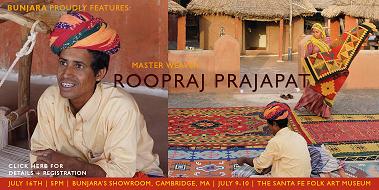
Archives
Contribute
| Renowned Indian Master Weaver Roopraj Prajapat To Make First US Appearance At Bunjara |
Press Release
06/28/2005
Bunjara, provider of fine antique furniture, handwoven rugs and handcrafted gifts from India, today announced that renowned Indian master weaver, Roopraj, will be exhibiting his distinctive pieces of artwork and demonstrating his family’s century-old dhurrie weaving technique at their gallery on July 16, 2005. As the descendant of a long line of weavers, Roopraj Prajapat’s fine craftsmanship has led him to participate in exhibitions throughout the world but this is his first exhibition in the United States. After demonstrating at the Santa Fe International Folk Art Market where he was one of only 75 folk artists chosen from a worldwide pool, he will be demonstrating his fine technique when he makes a stop at Bunjara based here.
Roopraj Prajapat, is one of the finest exponents of the centuries old Indian tradition of weaving handwoven dhurries. Like kilims of Turkey, Central Asia and other regions, dhurries are flat textiles commonly used today as rugs and historically have been used as floor and bed coverings or an under-layer to the more intricate woolen Persian rugs of the Mughal era. In the late eighteenth century, India’s ruling Rajput families of Rajasthan began using dhurries to decorate their palaces. These royal commissions enhanced the development of rug weaving and ensured the survival of this tradition to the present day where the creation of dhurries has remained relatively unchanged.
The floral and geometric patterns and motifs of Persian kilims that influenced the design of Indian dhurries in the 18th and 19th centuries are seen today in the designs of Roopraj’s dhurries. His family has been involved in weaving for at least 200 years. His unique pieces of artwork are woven on a traditional horizontal simple wood loom using colorfast yarn made out of cotton, wool, goat or camel hair and a tapestry weave. In this technique, the interlaced weft yarns are tightly compacted with a wooden beater, almost covering the warp yarns completely. As demand for Roopraj’s dhurries has grown, he has created a unique organization spanning seventeen villages that provides several hundred families with their primary source of income. It seems to be a perfect example out of some B-School organizational theory class. A tightly knit but loosely controlled decentralized organization in the middle of the Thar Desert in Rajasthan! The weavers live in humble but clean rural dwellings and are happy to uphold centuries old traditions. Compared to other rural to urban drifters who get economically and socially lost as they crowd big cities in search of employment, Roopraj’s marketing ability brings the weavers of Salawas income with respect and dignity in their own dhanis.
Roopraj is pleased to have met and shared his work on the symbolism of the JeevanVriksh (Tree of Life) with celebrities such as Richard Gere and looks forward to sharing his work and that of his organization with more of the Western world.
Bunjara is the exclusive provider of Roopraj’s dhurries in the United States and specializes in antique furniture and handcrafted gifts from the Indian sub-continent. With a goal of providing their discerning customers with superior service and the widest selection of unique products at competitive prices, they selectively handpick their inventory, and work directly with artisans and suppliers. Bunjara has long-standing personal relationships with the key suppliers in India giving them unparalleled access to products that otherwise travel through several other middlemen before reaching the consumer.
The exhibition and demonstration will be held on July 16th at 5:00 p.m. at the Bunjara gallery located at 366B Broadway in Cambridge. For more information or directions, call (617) 491.2121 or visit www.bunjara.com.

You may also access this article through our web-site http://www.lokvani.com/
